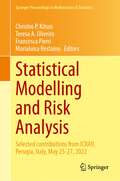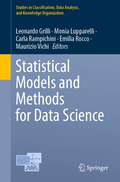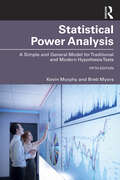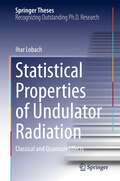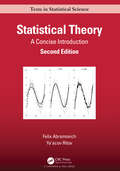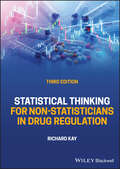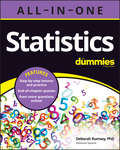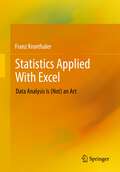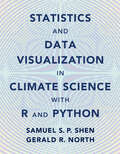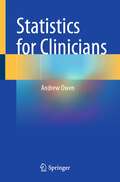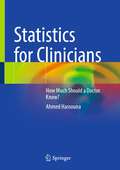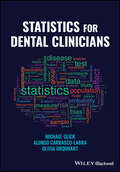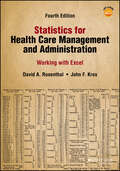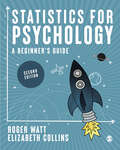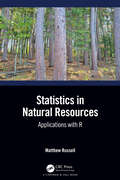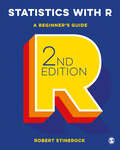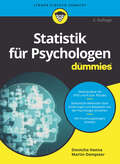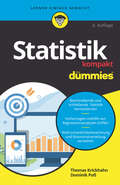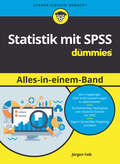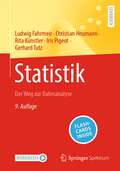- Table View
- List View
Statistical Modelling and Risk Analysis: Selected contributions from ICRA9, Perugia, Italy, May 25-27, 2022 (Springer Proceedings in Mathematics & Statistics #430)
by Christos P. Kitsos Teresa A. Oliveira Francesca Pierri Marialuisa RestainoThis volume covers the latest results on novel methods in Risk Analysis and assessment, with applications in Biostatistics (which is providing food for thought since the first ICRAs, covering traditional areas of RA, until now), Engineering Reliability, the Environmental Sciences and Economics. The contributions, based on lectures given at the 9th International Conference on Risk Analysis (ICRA 9), at Perugia, Italy, May 2022, detail a wide variety of daily risks, building on ideas presented at previous ICRA conferences. Working within a strong theoretical framework, supporting applications, the material describes a modern extension of the traditional research of the 1980s. This book is intended for graduate students in Mathematics, Statistics, Biology, Toxicology, Medicine, Management, and Economics, as well as quantitative researchers in Risk Analysis.
Statistical Models and Methods for Data Science (Studies in Classification, Data Analysis, and Knowledge Organization)
by Maurizio Vichi Emilia Rocco Leonardo Grilli Monia Lupparelli Carla RampichiniThis book focuses on methods and models in classification and data analysis and presents real-world applications at the interface with data science. Numerous topics are covered, ranging from statistical inference and modelling to clustering and factorial methods, and from directional data analysis to time series analysis and small area estimation. The applications deal with new developments in a variety of fields, including medicine, finance, engineering, marketing, and cyber risk.The contents comprise selected and peer-reviewed contributions presented at the 13th Scientific Meeting of the Classification and Data Analysis Group of the Italian Statistical Society, CLADAG 2021, held (online) in Florence, Italy, on September 9–11, 2021. CLADAG promotes advanced methodological research in multivariate statistics with a special focus on data analysis and classification, and supports the exchange and dissemination of ideas, methodological concepts, numerical methods, algorithms, and computational and applied results at the interface between classification and data science.
Statistical Power Analysis: A Simple and General Model for Traditional and Modern Hypothesis Tests, Fifth Edition
by Kevin R. Murphy Brett MyorsStatistical Power Analysis explains the key concepts in statistical power analysis and illustrates their application in both tests of traditional null hypotheses (that treatments or interventions have no effect in the population) and in tests of the minimum-effect hypotheses (that the population effects of treatments or interventions are so small that they can be safely treated as unimportant). It provides readers with the tools to understand and perform power analyses for virtually all the statistical methods used in the social and behavioral sciences. Brett Myors and Kevin Murphy apply the latest approaches of power analysis to both null hypothesis and minimum-effect testing using the same basic unified model. This book starts with a review of the key concepts that underly statistical power. It goes on to show how to perform and interpret power analyses, and the ways to use them to diagnose and plan research. We discuss the uses of power analysis in correlation and regression, in the analysis of experimental data, and in multilevel studies. This edition includes new material and new power software. The programs used for power analysis in this book have been re-written in R, a language that is widely used and freely available. The authors include R codes for all programs, and we have also provided a web-based app that allows users who are not comfortable with R to perform a wide range of analyses using any computer or device that provides access to the web. Statistical Power Analysis helps readers design studies, diagnose existing studies, and understand why hypothesis tests come out the way they do. The fifth edition includes updates to all chapters to accommodate the most current scholarship, as well as recalculations of all examples. This book is intended for graduate students and faculty in the behavioral and social sciences; researchers in other fields will find the concepts and methods laid out here valuable and applicable to studies in many domains.
Statistical Properties of Undulator Radiation: Classical and Quantum Effects (Springer Theses)
by Ihar LobachThis thesis presents significant advances in the understanding of the statistical properties of undulator radiation via two experiments carried out in the Integrable Optics Test Accelerator (IOTA) storage ring at Fermilab. The first experiment studied the turn-to-turn fluctuations in the power of the radiation generated by an electron bunch. The magnitude of these fluctuations depends on the 6D phase-space distribution of the electron bunch. The author presents the most complete theoretical description of this effect to date, and shows that it can be used to measure some electron bunch parameters (e.g. its size and divergence). Remarkably, the performance of this technique improves for smaller bunches and shorter radiation wavelengths and it may, therefore, be particularly beneficial for existing state-of-the-art and next-generation low-emittance high-brightness x-ray synchrotron light sources. In the second experiment, a single electron was stored in the ring, emitting a photon only once per several hundred turns. In this regime, any classical interference-related collective effects were eliminated, and the quantum fluctuations could be studied in detail to search for possible deviations from the expected Poissonian photon statistics. In addition, the photocount arrival times were used to track the longitudinal motion of a single electron and to compare it with simulations. This served as an independent measurement of several dynamical parameters of the storage ring.
Statistical Theory: A Concise Introduction (Chapman & Hall/CRC Texts in Statistical Science #100)
by Felix Abramovich Ya'acov RitovDesigned for a one-semester advanced undergraduate or graduate statistical theory course, Statistical Theory: A Concise Introduction, Second Edition clearly explains the underlying ideas, mathematics, and principles of major statistical concepts, including parameter estimation, confidence intervals, hypothesis testing, asymptotic analysis, Bayesian inference, linear models, nonparametric statistics, and elements of decision theory. It introduces these topics on a clear intuitive level using illustrative examples in addition to the formal definitions, theorems, and proofs. Based on the authors’ lecture notes, the book is self-contained, which maintains a proper balance between the clarity and rigor of exposition. In a few cases, the authors present a "sketched" version of a proof, explaining its main ideas rather than giving detailed technical mathematical and probabilistic arguments. Features: Second edition has been updated with a new chapter on Nonparametric Estimation; a significant update to the chapter on Statistical Decision Theory; and other updates throughout No requirement for heavy calculus, and simple questions throughout the text help students check their understanding of the material Each chapter also includes a set of exercises that range in level of difficulty Self-contained, and can be used by the students to understand the theory Chapters and sections marked by asterisks contain more advanced topics and may be omitted Special chapters on linear models and nonparametric statistics show how the main theoretical concepts can be applied to well-known and frequently used statistical tools The primary audience for the book is students who want to understand the theoretical basis of mathematical statistics—either advanced undergraduate or graduate students. It will also be an excellent reference for researchers from statistics and other quantitative disciplines.
Statistical Thinking for Non-Statisticians in Drug Regulation
by Richard KaySTATISTICAL THINKING FOR NON-STATISTICIANS IN DRUG REGULATION Statistical methods in the pharmaceutical industry are accepted as a key element in the design and analysis of clinical studies. Increasingly, the medical and scientific community are aligning with the regulatory authorities and recognizing that correct statistical methodology is essential as the basis for valid conclusions. In order for those correct and robust methods to be successfully employed there needs to be effective communication across disciplines at all stages of the planning, conducting, analyzing and reporting of clinical studies associated with the development and evaluation of new drugs and devices. Statistical Thinking for Non-Statisticians in Drug Regulation provides a comprehensive in-depth guide to statistical methodology for pharmaceutical industry professionals, including physicians, investigators, medical science liaisons, clinical research scientists, medical writers, regulatory personnel, statistical programmers, senior data managers and those working in pharmacovigilance. The author’s years of experience and up-to-date familiarity with pharmaceutical regulations and statistical practice within the wider clinical community make this an essential guide for the those working in and with the industry. The third edition of Statistical Thinking for Non-Statisticians in Drug Regulation includes: A detailed new chapter on Estimands in line with the 2019 Addendum to ICH E9 Major new sections on topics including Combining Hierarchical Testing and Alpha Adjustment, Biosimilars, Restricted Mean Survival Time, Composite Endpoints and Cumulative Incidence Functions, Adjusting for Cross-Over in Oncology, Inverse Propensity Score Weighting, and Network Meta-Analysis Updated coverage of many existing topics to reflect new and revised guidance from regulatory authorities and author experience Statistical Thinking for Non-Statisticians in Drug Regulation is a valuable guide for pharmaceutical and medical device industry professionals, as well as statisticians joining the pharmaceutical industry and students and teachers of drug development.
Statistics All-in-One For Dummies
by Deborah J. RumseyThe odds-on best way to master stats. Statistics All-in-One For Dummies is packed with lessons, examples, and practice problems to help you slay your stats course. Develop confidence and understanding in statistics with easy-to-understand (even fun) explanations of key concepts. Plus, you’ll get access to online chapter quizzes and other resources that will turn you into a stats master. This book teaches you how to interpret graphs, determine probability, critique data, and so much more. Written by an expert author and serious statistics nerd, Statistics AIO For Dummies explains everything in terms anyone can understand. Get a grasp of basic statistics concepts required in every statistics course Clear up the process of interpreting graphs, understanding polls, and analyzing data Master correlation, regression, and other data analysis tools Score higher on stats tests and get a better grade in your high school or college classStatistics All-in-One For Dummies follows the curriculum of intro college statistics courses (including AP Stats!) so you can learn everything you need to know to get the grade you need—the Dummies way.
Statistics Applied With Excel: Data Analysis Is (Not) an Art
by Franz KronthalerThis book shows you how to analyze data sets systematically and to use Excel 2019 to extract information from data almost effortlessly. Both are (not) an art!The statistical methods are presented and discussed using a single data set. This makes it clear how the methods build on each other and gradually more and more information can be extracted from the data. The Excel functions used are explained in detail - the procedure can be easily transferred to other data sets. Various didactic elements facilitate orientation and working with the book: At the checkpoints, the most important aspects from each chapter are briefly summarized. In the freak knowledge section, more advanced aspects are addressed to whet the appetite for more. All examples are calculated with hand and Excel. Numerous applications and solutions as well as further data sets are available on the author's internet platform. This book is a translation of the original German 2nd edition Statistik angewandt mit Excel by Franz Kronthaler, published by Springer-Verlag GmbH Germany, part of Springer Nature in 2021. The translation was done with the help of artificial intelligence (machine translation by the service DeepL.com). A subsequent human revision was done primarily in terms of content, so that the book will read stylistically differently from a conventional translation. Springer Nature works continuously to further the development of tools for the production of books and on the related technologies to support the authors.
Statistics and Data Visualization in Climate Science with R and Python
by Gerald R. North Samuel S. P. ShenStatistics at Square Two: Understanding Modern Statistical Applications In Medicine
by Michael J. Campbell Richard M. JacquesSTATISTICS AT SQUARE TWO An easy-to-follow exploration of intermediate statistical techniques used in medical research In the newly revised third edition of Statistics at Square Two: Understanding Modern Statistical Applications in Medicine, a team of distinguished statisticians delivers an accessible and intuitive discussion of advanced statistical methods for readers and users of scientific medical literature. This will allow readers to engage critically with modern research as the authors explain the correct interpretation of results in the medical literature. The book includes two brand new chapters covering meta-analysis and time-series analysis as well as new references to the many checklists that have appeared in recent years to enable better reporting of contemporary research. Most examples have been updated as well, and each chapter contains practice exercises and answers. Readers will also find sample code (in R) for many of the analyses, in addition to: A thorough introduction to models and data, including the different types of data, statistical models, and computer-intensive methods Comprehensive explorations of multiple linear regression, including the interpretation of computer output, diagnostic statistics such as influential points, and many uses of multiple regression Practical discussions of multiple logistic regression, survival analysis, Poisson regression and random effects models including their uses, examples in the medical literature, and strategies for interpreting computer output Perfect for anyone hoping to better understand the statistics presented in contemporary medical research, Statistics at Square Two: Understanding Modern Statistical Applications in Medicine will also benefit postgraduate students studying statistics and medicine.
Statistics for Clinicians
by Andrew OwenThis book provides clinical medicine readers with a detailed explanation of statistical concepts using non-technical terms. This allows clinicians and others without specialist statistical knowledge to understand the medical literature where such concepts are used. Many examples from the medical literature are used to exemplify how these concepts are used in practice. Current books written for clinicians fall into two broad categories. Simple texts that are not designed to cover many important statistical concepts used in the medical literature. Comprehensive texts which cover many statistical principles in detail, including statistical theory, but which are more challenging to read and do not always cover many important statistical techniques used in the medical literature. This book assists in the understanding of these techniques.Statistics for Clinicians covers such topics in a robust non-technical manner accessible to clinicians and is intended for hospital consultants, junior doctors and general practitioners. Undergraduates in biomedical sciences and medicine may also find some sections valuable.
Statistics for Clinicians: How Much Should a Doctor Know?
by Ahmed HassounaHow much statistics does a clinician, surgeon or nurse need to know?This book provides an essential handbook to help appraise evidence in a scientific paper, to design and interpret the results of research correctly, to guide our students and to review the work of our colleagues. This title is written by a clinician exclusively for fellow clinicians, in their own language and not in statistical or epidemiological terms.When clinicians discuss probability, it is focussed on how it applies to the management of patients in the flesh and how they are managed in a clinical setting. Statistics for Clinicians does not overlook the basis of statistics, but reviews techniques specific to medicine with an emphasis on their application. It ensures that readers have the correct tools to hand, including worked examples, guides and links to online calculators and free software, enabling readers to execute most statistical calculations. This book will therefore be enormously helpful for many working across all fields of medicine at any stage of their career.
Statistics for Dental Clinicians
by Michael Glick Alonso Carrasco-Labra Olivia UrquhartSTATISTICS FOR DENTAL CLINICIANS Enables clinicians to understand how biostatistics relate and apply to dental clinical practice?? Statistics for Dental Clinicians??helps dental practitioners to understand and interpret the scientific literature and apply the concepts to their clinical practice. Written using clear, accessible language, the book breaks down complex statistical and study design principles and demonstrates how statistics can inform clinical practice. Chapters cover the basic building blocks of statistics, including clinical study designs, descriptive and inferential statistical concepts, and interpretation of study results, including differentiating between clinical and statistical significance. An extensive glossary of statistical terms, as well as graphs, figures, tables, and illustrations are included throughout to improve reader comprehension. Select readings accompany each chapter.?? Statistics for Dental Clinicians??includes information on:?? How to understand and interpret the scientific language used in the biomedical literature and statistical concepts that underlie evidence-based dentistry What is statistics and why do we need it, and how to effectively apply study results to clinical practice Understanding and interpreting standard deviations, standard errors, p-values, confidence intervals, sample sizes, correlations, survival analyses, probabilistic-based diagnosis, regression modeling, and patient-reported outcome measures Understanding and interpreting absolute risks, relative risks and odds ratios, as well as randomized controlled trials, cohort studies, case-control studies, cross-sectional studies, meta-analysis, bias and confounding With comprehensive coverage of a broad topic, written using accessible language and shining light on statistical complexity often found in writings related to clinical topics, Statistics for Dental Clinicians??is an essential guide for any dental practitioner wishing to improve their understanding of the biomedical literature.
Statistics for Health Care Management and Administration: Working with Excel (Public Health/Epidemiology and Biostatistics)
by John F. Kros David A. RosenthalThe must-have statistics guide for students of health services Statistics for Health Care Management and Administration: Working with Excel introduces the uses of statistics in healthcare management and administration using the features and functions of Microsoft Excel. The book introduces students to statistics within the context of health care, focusing on the major data and analysis techniques used in the field. Step-by-step instructions in the latest version of Excel and numerous annotated screen shots make examples easy to follow and understand. This updated fourth edition provides the same content and explanations that have made the previous editions so popular, offering revisions drawn directly from universities where the book has been used. All content has been brought current with the newest version of excel, and changes in the field of healthcare administration are covered as well. Statistics for Health Care Management and Administration gets students off to a great start by introducing statistics in the context of their chosen field. Learn the basics of statistics in the context of Excel Understand how to acquire data and display it for analysis Master important concepts and tests, including regression Turn test results into usable information with proper analysisThis book not only helps students develop the necessary data analysis skills, but also boosts familiarity with important software that employers will be looking for.
Statistics for Psychology: A Beginner′s Guide
by Elizabeth Collins Roger WattStatistics for Psychology is an interactive, highly visual, and accessible guide to the statistical practices you will encounter as a psychology student. Its software-agnostic approach keeps the focus on the core principles, rather than getting bogged down in complicated formulae and jargon. This book is based on the authors′ BPS commended programme. It focusses on providing the strong foundational understanding you’ll need to use statistics confidently and creatively rather than the software-specific way in which statistics is often taught. This edition includes: new content throughout on being a responsible researcher, a new chapter to support you in presenting your research to a critical audience, carefully designed graphics to explain statistical principles, "your turn" exercises to test your understanding of each chapter. This book is the ideal guide for students approaching statistics and research methods in psychology for the first time. Roger Watt is Emeritus Professor of Psychology at the University of Stirling. Elizabeth Collins is a researcher with a PhD in Psychology.
Statistics for Psychology: A Beginner′s Guide
by Elizabeth Collins Roger WattStatistics for Psychology is an interactive, highly visual, and accessible guide to the statistical practices you will encounter as a psychology student. Its software-agnostic approach keeps the focus on the core principles, rather than getting bogged down in complicated formulae and jargon. This book is based on the authors′ BPS commended programme. It focusses on providing the strong foundational understanding you’ll need to use statistics confidently and creatively rather than the software-specific way in which statistics is often taught. This edition includes: new content throughout on being a responsible researcher, a new chapter to support you in presenting your research to a critical audience, carefully designed graphics to explain statistical principles, "your turn" exercises to test your understanding of each chapter. This book is the ideal guide for students approaching statistics and research methods in psychology for the first time. Roger Watt is Emeritus Professor of Psychology at the University of Stirling. Elizabeth Collins is a researcher with a PhD in Psychology.
Statistics in Natural Resources: Applications with R
by Matthew RussellTo manage our environment sustainably, professionals must understand the quality and quantity of our natural resources. Statistical analysis provides information that supports management decisions and is universally used across scientific disciplines. Statistics in Natural Resources: Applications with R focuses on the application of statistical analyses in the environmental, agricultural, and natural resources disciplines. This is a book well suited for current or aspiring natural resource professionals who are required to analyze data and perform statistical analyses in their daily work. More seasoned professionals who have previously had a course or two in statistics will also find the content familiar. This text can also serve as a bridge between professionals who understand statistics and want to learn how to perform analyses on natural resources data in R. The primary goal of this book is to learn and apply common statistical methods used in natural resources by using the R programming language. If you dedicate considerable time to this book, you will: Develop analytical and visualization skills for investigating the behavior of agricultural and natural resources data. Become competent in importing, analyzing, and visualizing complex data sets in the R environment. Recode, combine, and restructure data sets for statistical analysis and visualization. Appreciate probability concepts as they apply to environmental problems. Understand common distributions used in statistical applications and inference. Summarize data effectively and efficiently for reporting purposes. Learn the tasks required to perform a variety of statistical hypothesis tests and interpret their results. Understand which modeling frameworks are appropriate for your data and how to interpret predictions. Includes over 130 exercises in R, with solutions available on the book’s website.
Statistics with R: A Beginner′s Guide
by Robert StinerockStatistics is made simple with this award-winning guide to using R and applied statistical methods. With a clear step-by-step approach explained using real world examples, learn the practical skills you need to use statistical methods in your research from an expert with over 30 years of teaching experience. With a wealth of hands-on exercises and online resources created by the author, practice your skills using the data sets and R scripts from the book with detailed screencasts that accompany each script. This book is ideal for anyone looking to: • Complete an introductory course in statistics • Prepare for more advanced statistical courses • Gain the transferable analytical skills needed to interpret research from across the social sciences • Learn the technical skills needed to present data visually • Acquire a basic competence in the use of R and RStudio. This edition also includes a gentle introduction to Bayesian methods integrated throughout. The author has created a wide range of online resources, including: over 90 R scripts, 36 datasets, 37 screen casts, complete solutions for all exercises, and 130 multiple-choice questions to test your knowledge.
Statistics with R: A Beginner′s Guide
by Robert StinerockStatistics is made simple with this award-winning guide to using R and applied statistical methods. With a clear step-by-step approach explained using real world examples, learn the practical skills you need to use statistical methods in your research from an expert with over 30 years of teaching experience. With a wealth of hands-on exercises and online resources created by the author, practice your skills using the data sets and R scripts from the book with detailed screencasts that accompany each script. This book is ideal for anyone looking to: • Complete an introductory course in statistics • Prepare for more advanced statistical courses • Gain the transferable analytical skills needed to interpret research from across the social sciences • Learn the technical skills needed to present data visually • Acquire a basic competence in the use of R and RStudio. This edition also includes a gentle introduction to Bayesian methods integrated throughout. The author has created a wide range of online resources, including: over 90 R scripts, 36 datasets, 37 screen casts, complete solutions for all exercises, and 130 multiple-choice questions to test your knowledge.
Statistik für Psychologen für Dummies (Für Dummies)
by Donncha Hanna Martin DempsterWer sich mit Psychologie beschäftigen will, muss sich meist auch mit Statistik beschäftigen und das auch noch recht umfassend. Wenn Statistik nicht so Ihr Thema ist, dann ist dies das richtige Buch für Sie. Donncha Hanna und Martin Dempster erklären Ihnen, was Sie über Regression, Korrelation und ANOVA wissen sollten. Sie erfahren, was Sie über Wahrscheinlichkeit, Deduktion und Hypothesentests wissen sollten und vieles mehr. Außerdem erhalten Sie eine kurze Einführung in SPSS sowie R beziehungsweise RStudio und lernen die für Sie wichtigen Funktionen dieser umfangreichen Programme kennen. So ist dieses Buch ein angenehmer Einstieg für alle, die sich nicht wirklich auf Statistik freuen.
Statistik kompakt für Dummies (Für Dummies)
by Thomas KrickhahnStatistik ist vielen ein Graus, doch keine Sorge! Thomas Krickhahn und Dominik Poß erklären Ihnen verständlich, aber kompakt zusammengefasst, worauf es in der Statistik ankommt: vom arithmetischen Mittel über Regressionsanalyse, Normalverteilung und Wahrscheinlichkeitsrechnung bis zum Hypothesentest. Dank erläuternder Beispiele sind auch schwierigere Formeln gut nachvollziehbar und so gelingt es Ihnen schnell, ein gutes Verständnis für die Grundlagen der Statistik zu gewinnen. So kann die nächste Prüfung kommen!
Statistik mit SPSS Alles in einem Band für Dummies (Für Dummies)
by Jürgen FaikReale Sachverhalte statistisch zu erschließen und zu analysieren ist eine hohe Kunst. Das Programmpaket SPSS ist dafür ein mächtiges Werkzeug. In diesem Buch lernen Sie anhand zahlreicher Beispiele, welche statistischen Verfahren es überhaupt gibt und wann welches Verfahren angemessen ist. Gleich im Anschluss erfahren Sie, wie diese Verfahren in SPSS implementiert sind und wie Sie sie in Ihrem Fachgebiet nutzen können. So finden Sie Zusammenhänge in Ihren Daten, die statistisch signifikant sind.
Statistik: Der Weg zur Datenanalyse
by Iris Pigeot Gerhard Tutz Ludwig Fahrmeir Christian Heumann Rita KünstlerDas Buch bietet eine umfassende Einführung in die Statistik. Die Autoren liefern eine integrierte Darstellung der deskriptiven Statistik, der modernen Methoden der explorativen Datenanalyse und der induktiven Statistik, einschließlich der Regressions- und Varianzanalyse. Zahlreiche Beispiele mit realen Daten veranschaulichen den Text. Geeignet als vorlesungsbegleitender Text, aber auch zum Selbststudium für Studierende der Wirtschafts- und Sozialwissenschaften sowie anderer Anwendungsdisziplinen und als Einführung für Studenten der Statistik.
Statistische Daten erheben und auswerten für Dummies (Für Dummies)
by Daniela Weber Daniela KellerSie müssen Arbeit mit statistischem Anteil schreiben und wissen nicht recht wie Sie vorgehen sollen, auch wenn Sie über theoretische Kenntnisse in Statistik verfügen? Dann hilft Ihnen dieses Buch. Daniela Weber und Daniela Keller erklären Ihnen Schritt für Schritt wie Sie vorgehen sollten. Sie starten mit den Fragen, die Sie sich schon zu Beginn stellen sollten, erklären dann einige Grundbegriffe und Methoden und erläutern dann wie Sie an die nötigen Daten kommen und diese schließlich auswerten. Zum Schluss erklären Ihnen die Autorinnen wie Sie Ihre Ergebnisse richtig beschreiben. So hilft Ihnen dieses Buch Ihrer Arbeit eine valide statistische Grundlage zu geben.
Statistische und mathematische Methoden in der Wirtschaft: Ein maschinen-generierter Literaturüberblick
by Vaibhavi AherDieses Buch vermittelt Wissen über die statistischen und mathematischen Methoden in der Wirtschaft und beinhaltet die Themenschwerpunkte Analyse, Schätzung und Vorhersage. In jedem Kapitel gibt es ein breites Spektrum an Forschungsarbeiten, die einen Einblick über das Thema geben sowie Beispiele für die Anwendung der Ökonometrie in realen Situationen. Das Buch enthält einen systematischen Literaturüberblick auf der Grundlage maschinell generierter Inhalte. Fragen und zugehörige Schlüsselwörter wurden für die Maschine vorbereitet, die sie abgefragt, entdeckt, zusammengestellt und durch Clustering mit künstlicher Intelligenz (KI) strukturiert hat. Springer Nature hat in den letzten Jahren viel zu dem Thema in Zeitschriften veröffentlicht, so dass die Herausforderung für die Maschine darin bestand, die relevantesten Inhalte zu identifizieren und sie in einer strukturierten Weise zu präsentieren. Die automatisch generierten Literaturzusammenfassungen dienen Wissenschaftlern und Studenten, um sich einen Überblick über die aktuelle Entwicklung des Themas zu verschaffen und Forschungsfragen zu entwickeln, aber auch Personen aus der Praxis erhalten Anregungen und Impulse.
